Abstract
Standard measures of subjective and discriminative effects of drugs were compared in 5 human volunteers. Subjects responded on a second-order color-tracking procedure, where 30 mg of d-amphetamine served as a discriminative stimulus for one response and its absence as the discriminative stimulus for another response. Self-reported subjective effects were assessed concurrently using the single-dose questionnaire, subscales of the Addiction Research Center Inventory, and several analogue rating scales. On different days following discrimination acquisition, varying doses of d-amphetamine, methamphetamine, and hydromorphone were administered. In these test sessions, either response was reinforced. Methamphetamine and d-amphetamine occasioned dose-related increases in d-amphetamine appropriate responding; hydromorphone did not. Methamphetamine and d-amphetamine occasioned dose-related increases in reports of the drug received being most like "speed"; hydromorphone occasioned dose-related increases in reports of the drug received being most like "dope." All three drugs occasioned dose-related increases in reports of drug liking, and increases in the morphine-benzedrine group, amphetamine, and benzedrine group scales of the Addiction Research Center Inventory. This experiment demonstrated that although explicit discriminative control of behavior by a drug may covary with drug identification, it does not necessarily covary with other self-reported subjective effects. Thus, the complementary nature of the data provided by drug discrimination and standard subjective-effects measures provides quantitative and qualitative data useful in studying both relatively novel compounds and the behavioral biology of psychoactive drugs in general.
Full text
PDF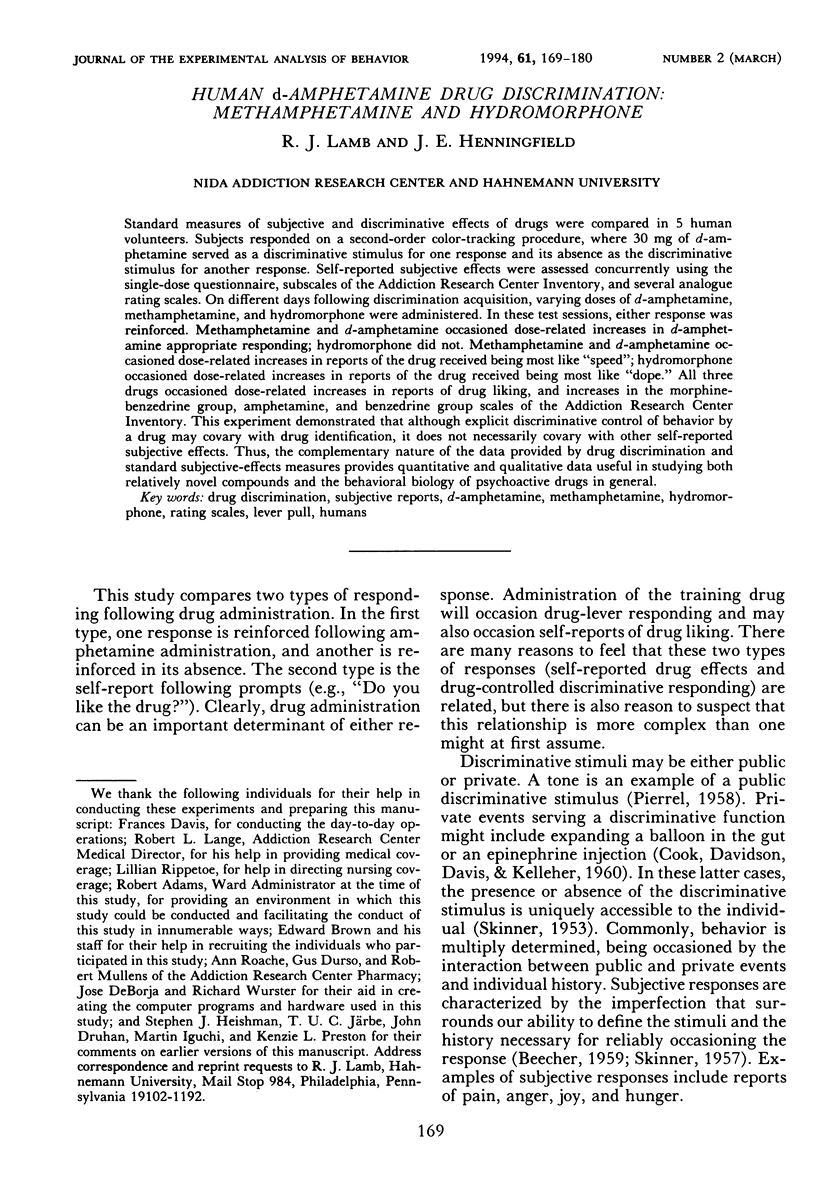
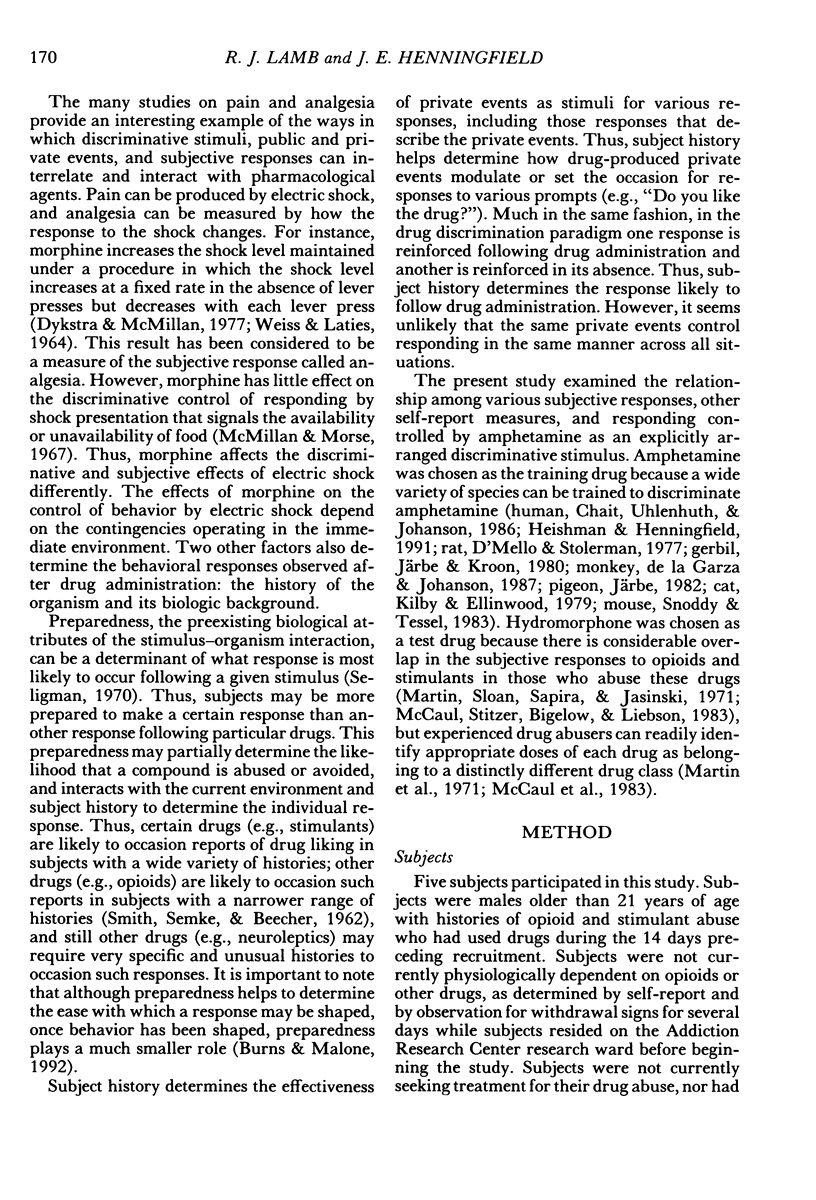
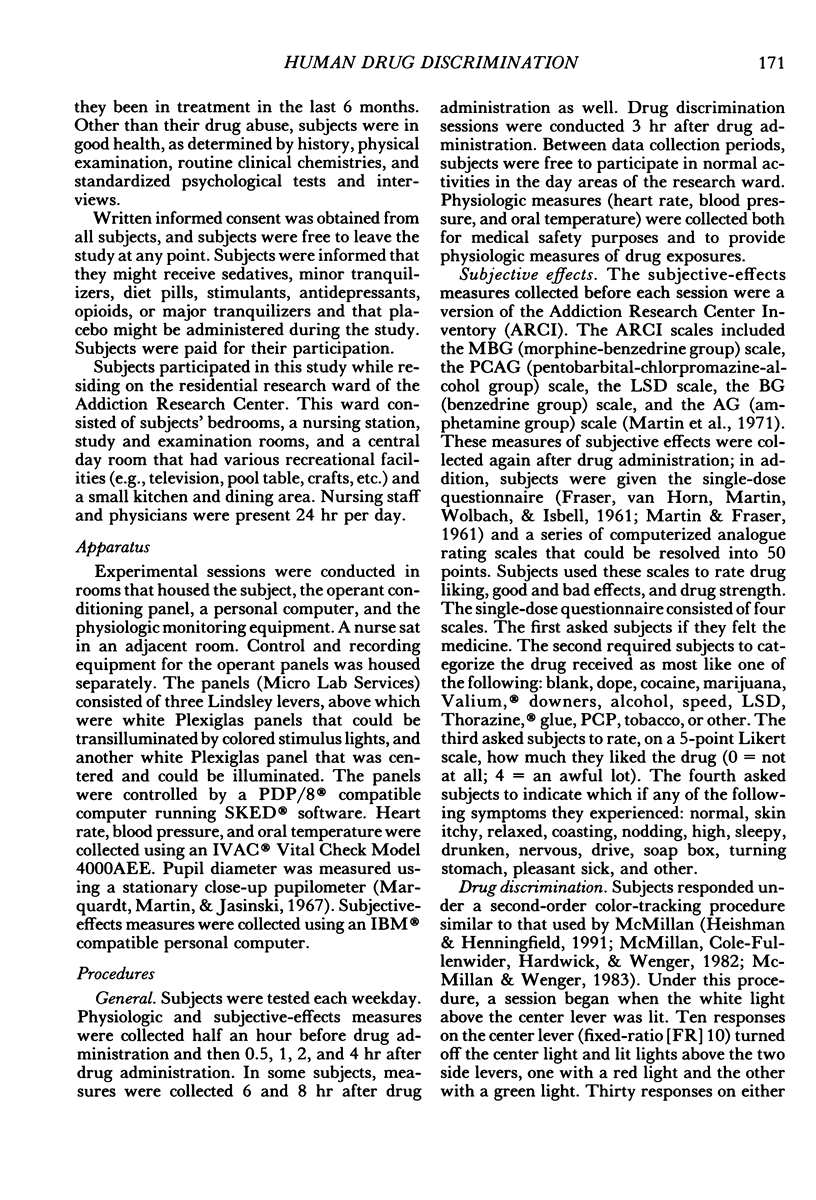
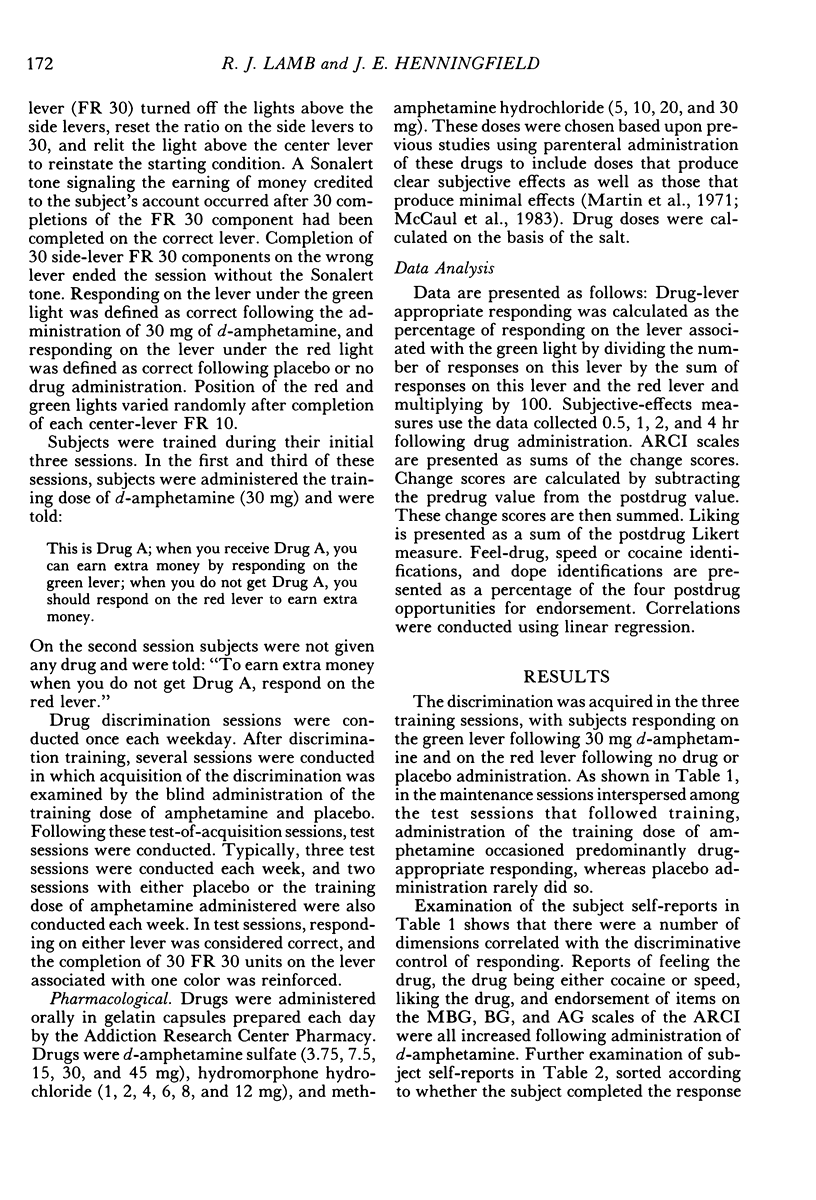
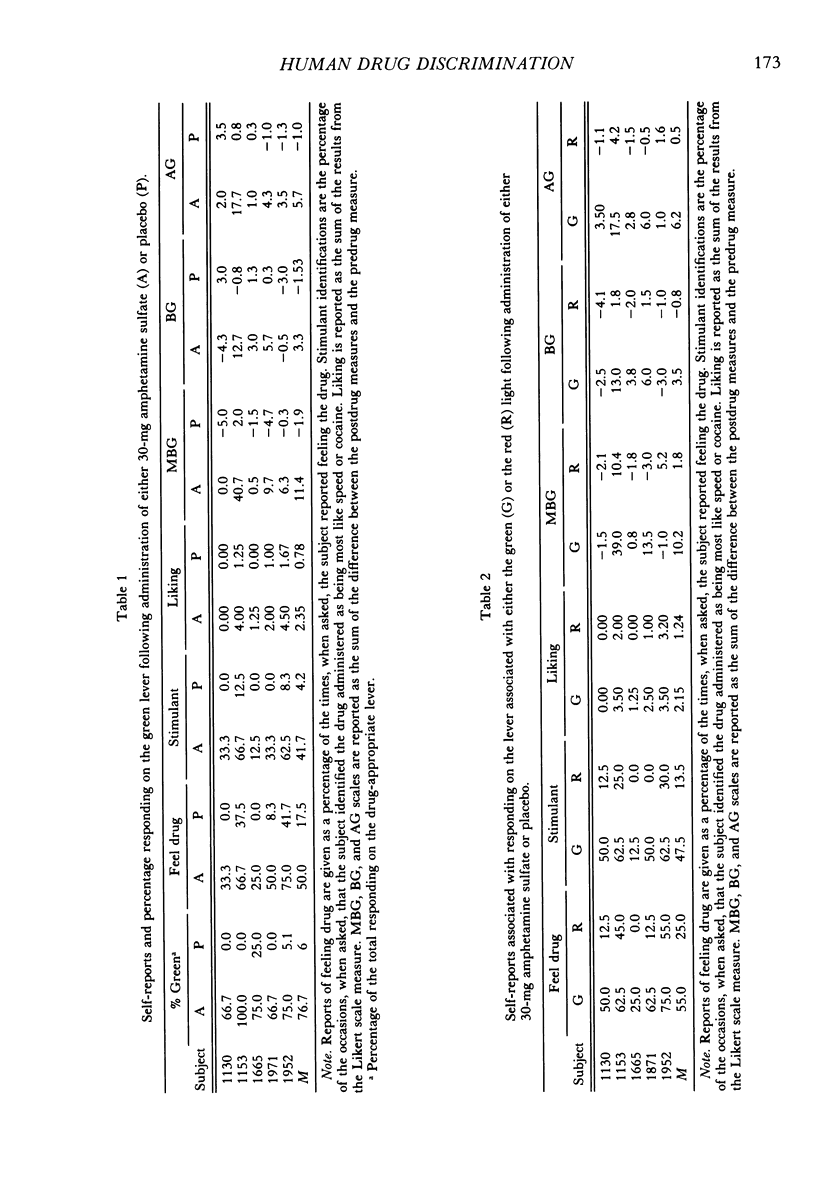
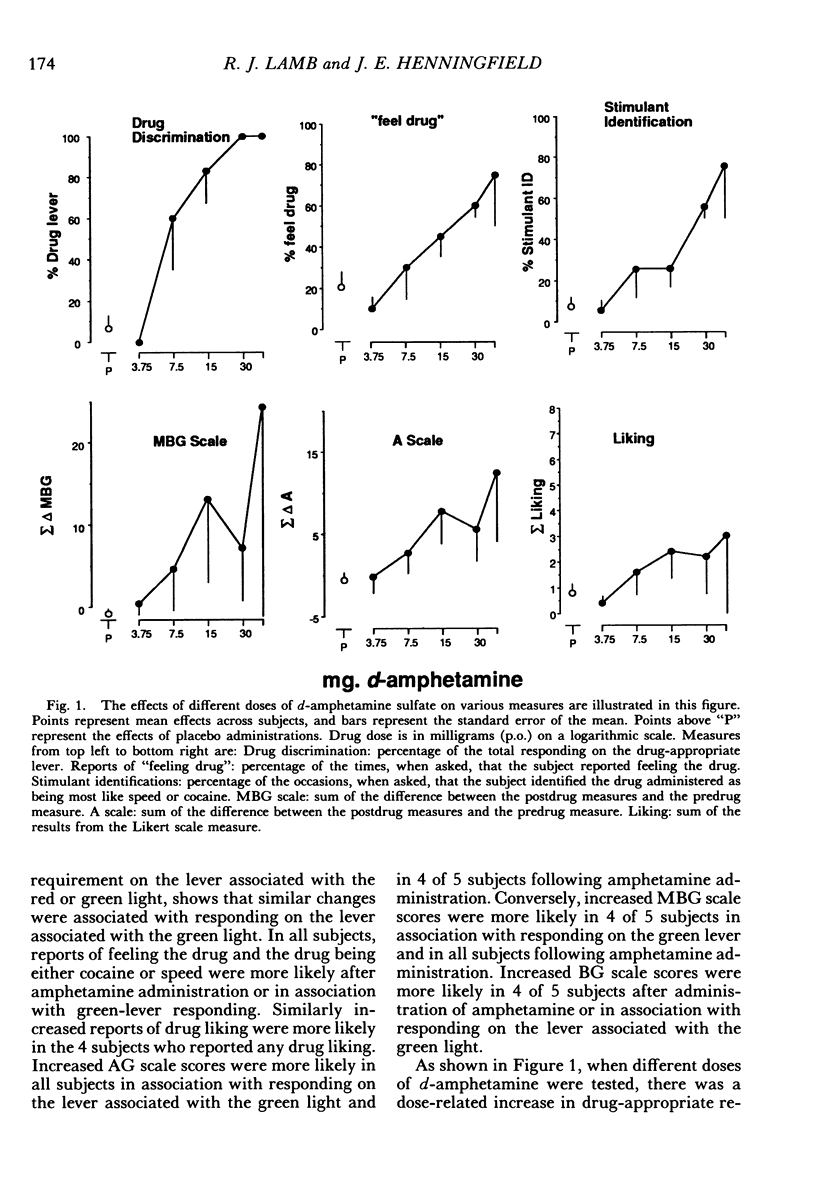
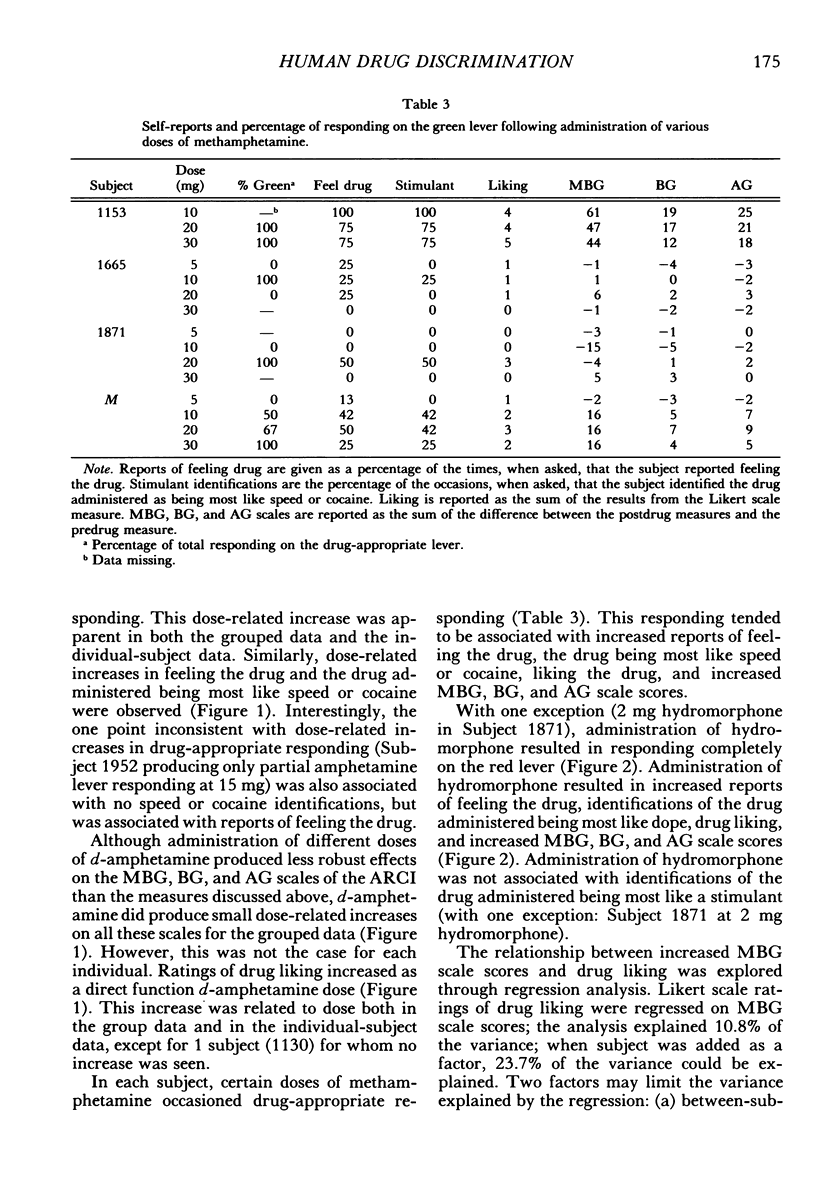
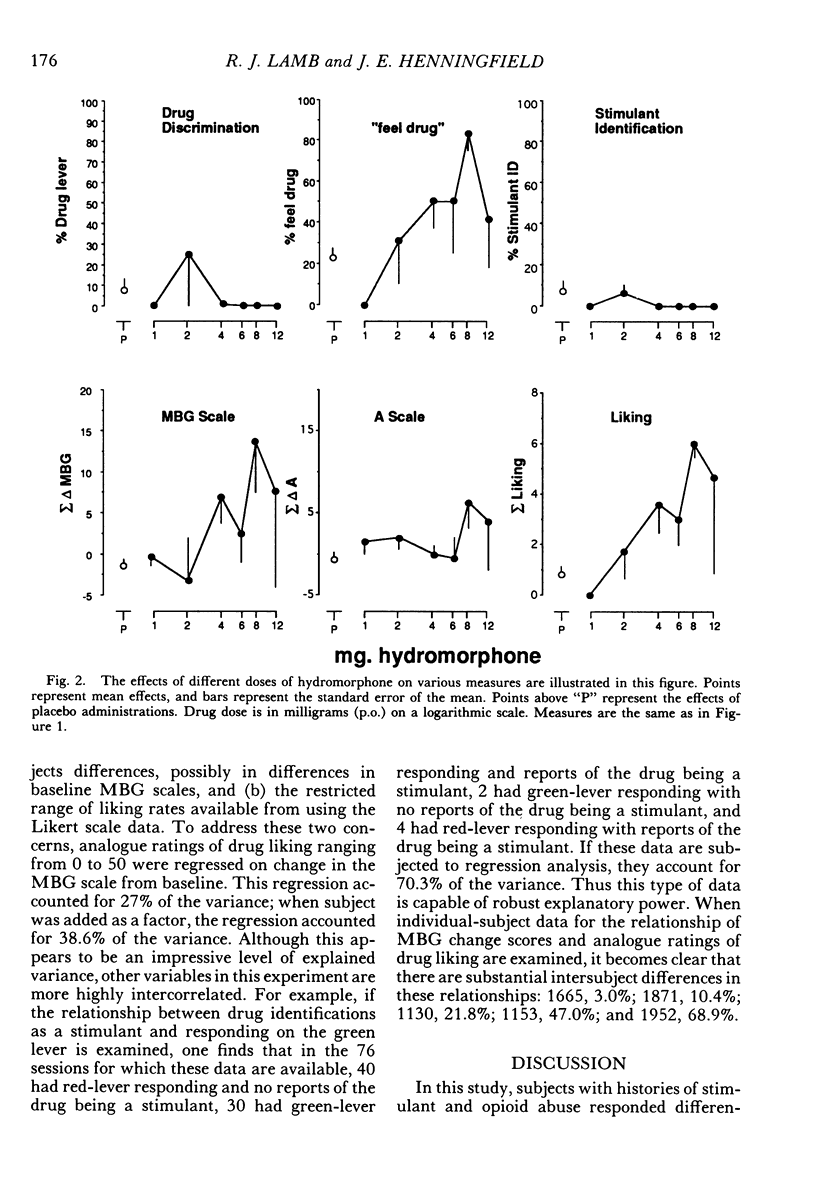
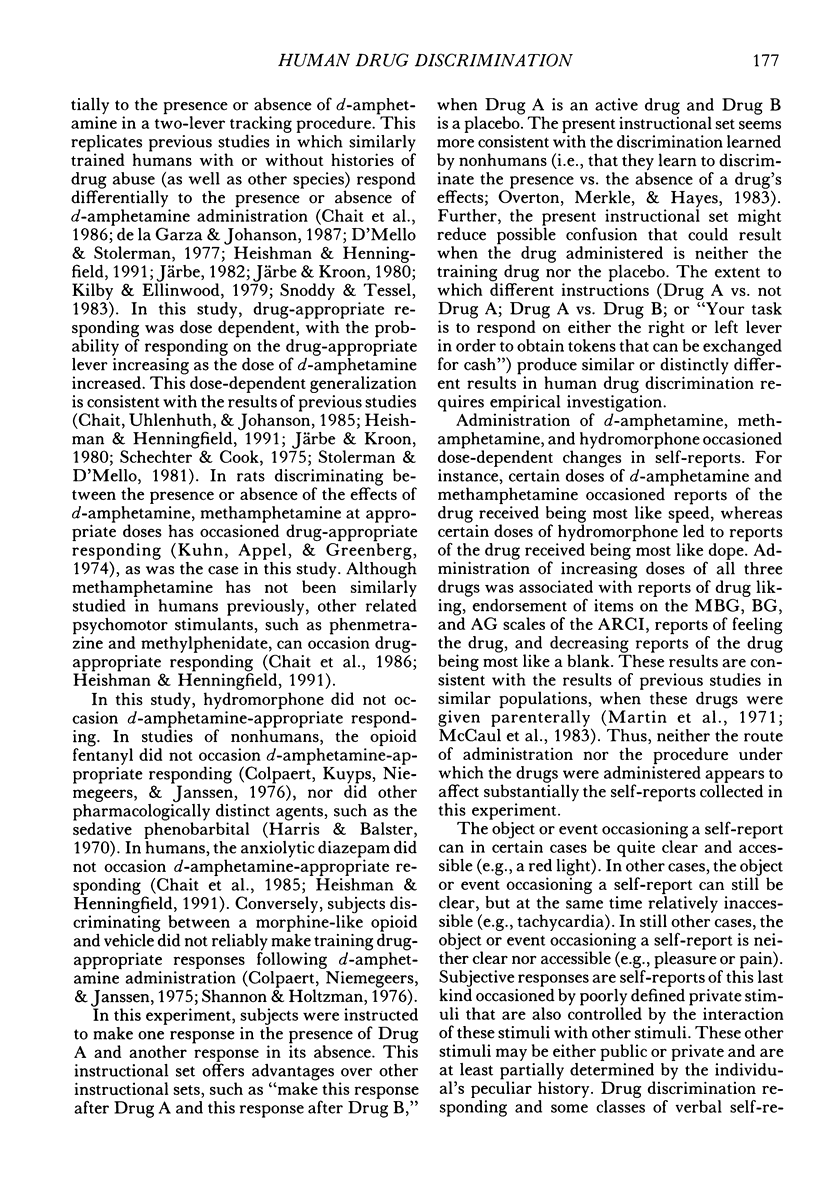
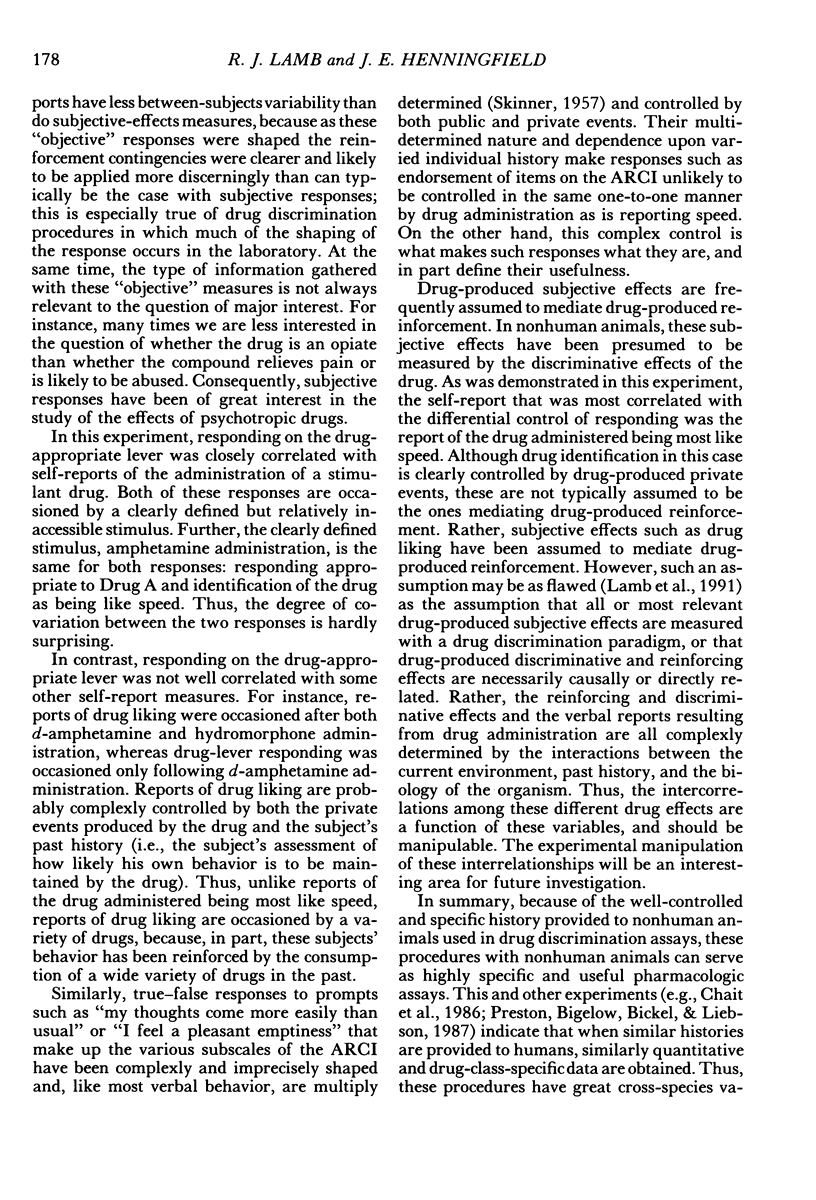
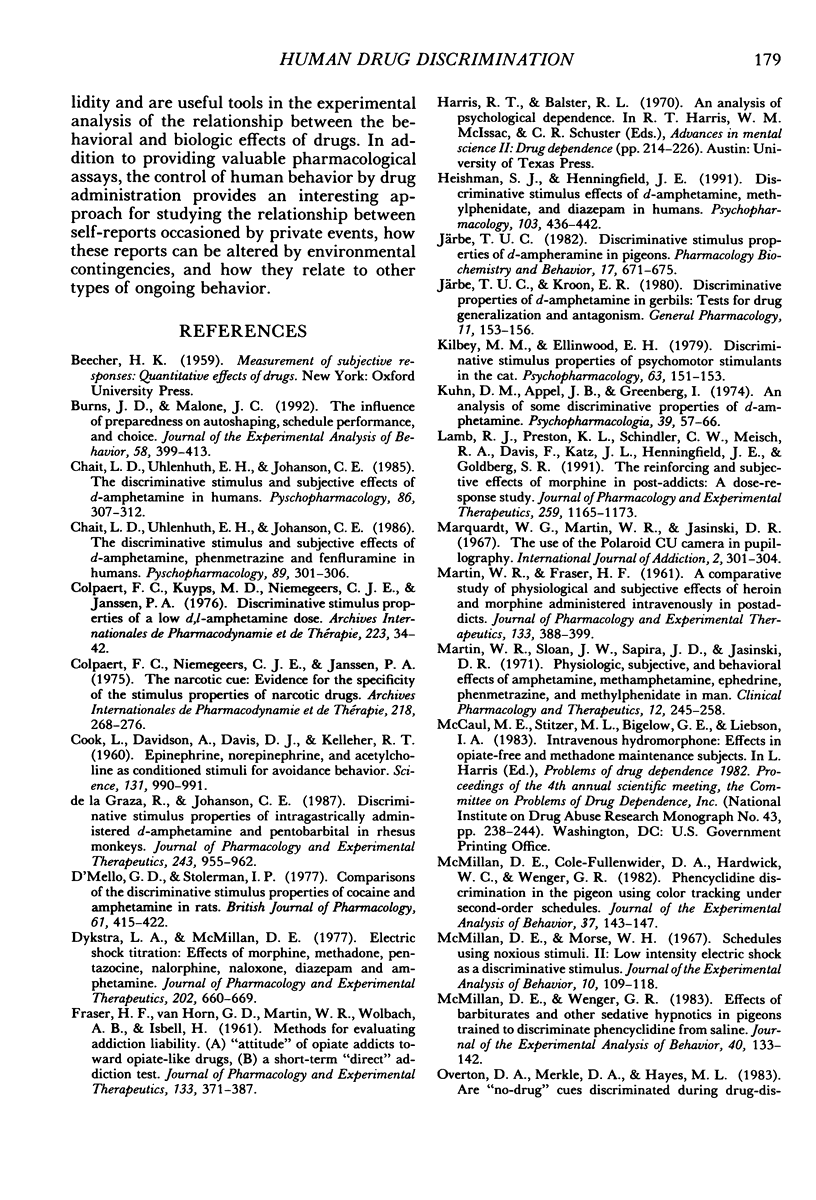
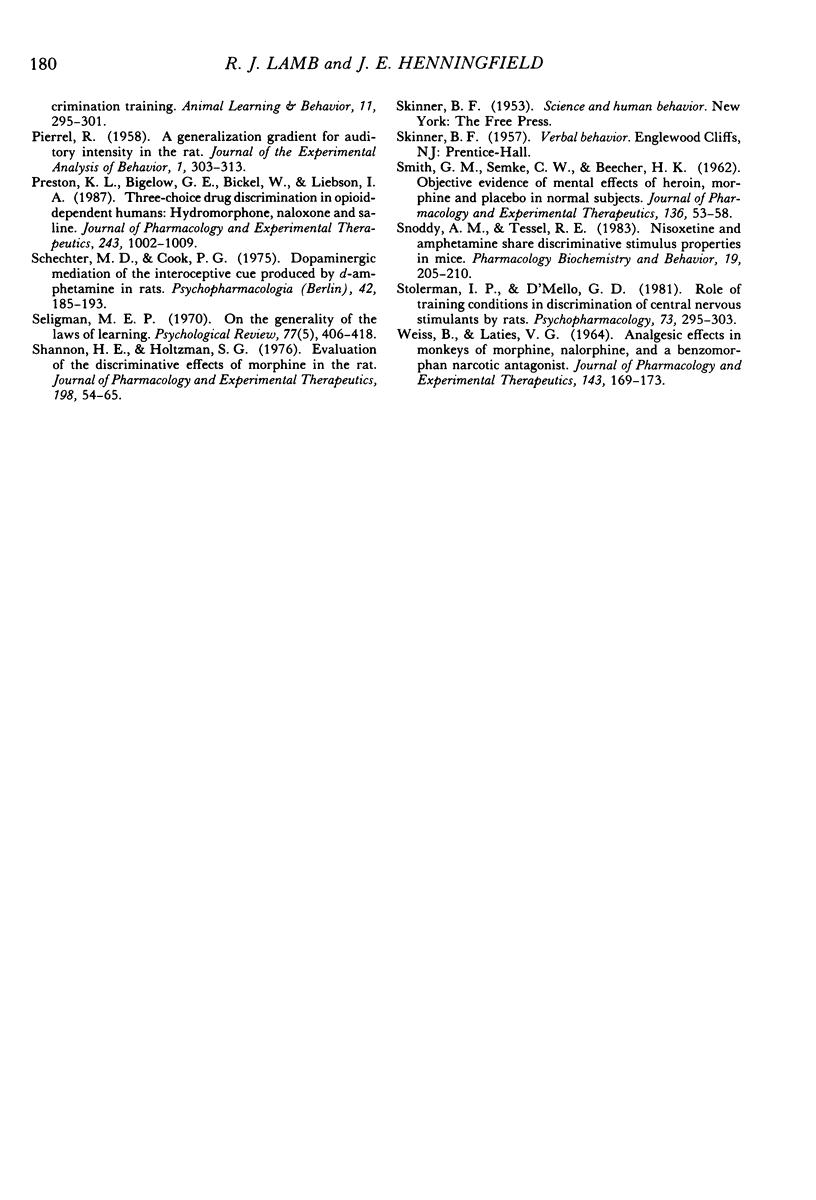
Selected References
These references are in PubMed. This may not be the complete list of references from this article.
- Burns J. D., Malone J. C., Jr The influence of "preparedness" on autoshaping, schedule performance, and choice. J Exp Anal Behav. 1992 Nov;58(3):399–413. doi: 10.1901/jeab.1992.58-399. [DOI] [PMC free article] [PubMed] [Google Scholar]
- COOK L., DAVIDSON A., DAVIS D. J., KELLEHER R. G. Epinephrine, norepinephrine, and acetylcholine as conditioned stimuli for avoidance behavior. Science. 1960 Apr 1;131(3405):990–991. doi: 10.1126/science.131.3405.990. [DOI] [PubMed] [Google Scholar]
- Chait L. D., Uhlenhuth E. H., Johanson C. E. The discriminative stimulus and subjective effects of d-amphetamine in humans. Psychopharmacology (Berl) 1985;86(3):307–312. doi: 10.1007/BF00432219. [DOI] [PubMed] [Google Scholar]
- Chait L. D., Uhlenhuth E. H., Johanson C. E. The discriminative stimulus and subjective effects of d-amphetamine, phenmetrazine and fenfluramine in humans. Psychopharmacology (Berl) 1986;89(3):301–306. doi: 10.1007/BF00174364. [DOI] [PubMed] [Google Scholar]
- Colpaert F. C., Kuyps J. J., Niemegeers C. J., Janssen P. A. Discriminative stimulus properties of a low dl-amphetamine dose. Arch Int Pharmacodyn Ther. 1976 Sep;223(1):34–42. [PubMed] [Google Scholar]
- Colpaert F. C., Niemegeers C. J., Janssen P. A. The narcotic cue: evidence for the specificity of the stimulus properties of narcotic drugs. Arch Int Pharmacodyn Ther. 1975 Dec;218(2):268–276. [PubMed] [Google Scholar]
- D'Mello G. D., Stolerman I. P. Comparison of the discriminative stimulus properties of cocaine and amphetamine in rats. Br J Pharmacol. 1977 Nov;61(3):415–422. doi: 10.1111/j.1476-5381.1977.tb08434.x. [DOI] [PMC free article] [PubMed] [Google Scholar]
- Dykstra L. A., McMillan D. E. Electric shock titration: effects of morphine, metadone, pentazocine, naloriphine, naloxone, diazepam and amphetamine. J Pharmacol Exp Ther. 1977 Sep;202(3):660–669. [PubMed] [Google Scholar]
- FRASER H. F., VAN HORN G. D., MARTIN W. R., WOLBACH A. B., ISBELL H. Methods for evaluating addiction liability. (A) "Attitude" of opiate addicts toward opiate-like drugs. (B) a short-term "direct" addiction test. J Pharmacol Exp Ther. 1961 Sep;133:371–387. [PubMed] [Google Scholar]
- Heishman S. J., Henningfield J. E. Discriminative stimulus effects of d-amphetamine, methylphenidate, and diazepam in humans. Psychopharmacology (Berl) 1991;103(4):436–442. doi: 10.1007/BF02244241. [DOI] [PubMed] [Google Scholar]
- Järbe T. U. Discriminative stimulus properties of d-amphetamine in pigeons. Pharmacol Biochem Behav. 1982 Oct;17(4):671–675. doi: 10.1016/0091-3057(82)90343-4. [DOI] [PubMed] [Google Scholar]
- Kilbey M. M., Ellinwood E. H., Jr Discriminative stimulus properties of psychomotor stimulants in the cat. Psychopharmacology (Berl) 1979 May 25;63(2):151–153. doi: 10.1007/BF00429694. [DOI] [PubMed] [Google Scholar]
- Kuhn D. M., Appel J. B., Greenberg I. An analysis of some discriminative properties of d-amphetamine. Psychopharmacologia. 1974;39(1):57–66. doi: 10.1007/BF00421458. [DOI] [PubMed] [Google Scholar]
- Lamb R. J., Preston K. L., Schindler C. W., Meisch R. A., Davis F., Katz J. L., Henningfield J. E., Goldberg S. R. The reinforcing and subjective effects of morphine in post-addicts: a dose-response study. J Pharmacol Exp Ther. 1991 Dec;259(3):1165–1173. [PubMed] [Google Scholar]
- MARQUARDT P., SCHUMACHER H., VOGG G. Die chemische Konstitution des blutdrucksenkenden Faktors in der Kartoffel. Arzneimittelforschung. 1952 Jul;2(7):301–304. [PubMed] [Google Scholar]
- MARTIN W. R., FRASER H. F. A comparative study of physiological and subjective effects of heroin and morphine administered intravenously in postaddicts. J Pharmacol Exp Ther. 1961 Sep;133:388–399. [PubMed] [Google Scholar]
- Martin W. R., Sloan J. W., Sapira J. D., Jasinski D. R. Physiologic, subjective, and behavioral effects of amphetamine, methamphetamine, ephedrine, phenmetrazine, and methylphenidate in man. Clin Pharmacol Ther. 1971 Mar-Apr;12(2):245–258. doi: 10.1002/cpt1971122part1245. [DOI] [PubMed] [Google Scholar]
- McMillan D. E., Cole-Fullenwider D. A., Hardwick W. C., Wenger G. R. Phencyclidine discrimination in the pigeon using color tracking under second-order schedule. J Exp Anal Behav. 1982 Jan;37(1):143–147. doi: 10.1901/jeab.1982.37-143. [DOI] [PMC free article] [PubMed] [Google Scholar]
- McMillan D. E., Morse W. H. Schedules using noxious stimuli. II: low intensity electric shock as a discriminative stimulus. J Exp Anal Behav. 1967 Jan;10(1):109–118. doi: 10.1901/jeab.1967.10-109. [DOI] [PMC free article] [PubMed] [Google Scholar]
- McMillan D. E., Wenger G. R. Effects of barbiturates and other sedative hypnotics in pigeons trained to discriminate phencyclidine from saline. J Exp Anal Behav. 1983 Sep;40(2):133–142. doi: 10.1901/jeab.1983.40-133. [DOI] [PMC free article] [PubMed] [Google Scholar]
- Pierrel R. A generalization gradient for auditory intensity in the rat. J Exp Anal Behav. 1958 Oct;1(4):303–313. doi: 10.1901/jeab.1958.1-303. [DOI] [PMC free article] [PubMed] [Google Scholar]
- Preston K. L., Bigelow G. E., Bickel W., Liebson I. A. Three-choice drug discrimination in opioid-dependent humans: hydromorphone, naloxone and saline. J Pharmacol Exp Ther. 1987 Dec;243(3):1002–1009. [PubMed] [Google Scholar]
- SMITH G. M., SEMKE C. W., BEECHER H. K. Objective evidence of mental effects of heroin, morphine and placebo in normal subjects. J Pharmacol Exp Ther. 1962 Apr;136:53–58. [PubMed] [Google Scholar]
- Schechter M. D., Cook P. G. Dopaminergic mediation of the interoceptive cue produced by d-amphetamine in rats. Psychopharmacologia. 1975 May 28;42(2):185–193. doi: 10.1007/BF00429551. [DOI] [PubMed] [Google Scholar]
- Shannon H. E., Holtzman S. G. Evaluation of the discriminative effects of morphine in the rat. J Pharmacol Exp Ther. 1976 Jul;198(1):54–65. [PubMed] [Google Scholar]
- Snoddy A. M., Tessel R. E. Nisoxetine and amphetamine share discriminative stimulus properties in mice. Pharmacol Biochem Behav. 1983 Aug;19(2):205–210. doi: 10.1016/0091-3057(83)90040-0. [DOI] [PubMed] [Google Scholar]
- Stolerman I. P., D'Mello G. D. Role of training conditions in discrimination of central nervous system stimulants by rats. Psychopharmacology (Berl) 1981;73(3):295–303. doi: 10.1007/BF00422421. [DOI] [PubMed] [Google Scholar]
- WEISS B., LATIES V. G. ANALGESIC EFFECTS IN MONKEYS OF MORPHINE, NALORPHINE, AND A BENZOMORPHAN NARCOTIC ANTAGONIST. J Pharmacol Exp Ther. 1964 Feb;143:169–173. [PubMed] [Google Scholar]
- de la Garza R., Johanson C. E. Discriminative stimulus properties of intragastrically administered d-amphetamine and pentobarbital in rhesus monkeys. J Pharmacol Exp Ther. 1987 Dec;243(3):955–962. [PubMed] [Google Scholar]


